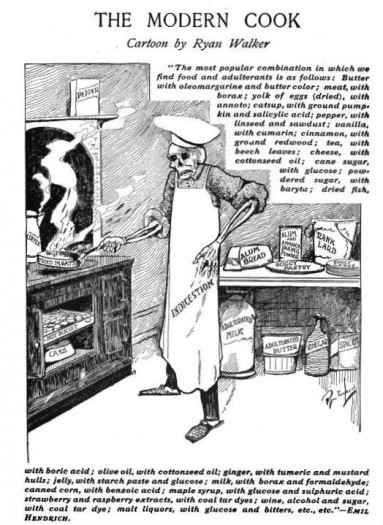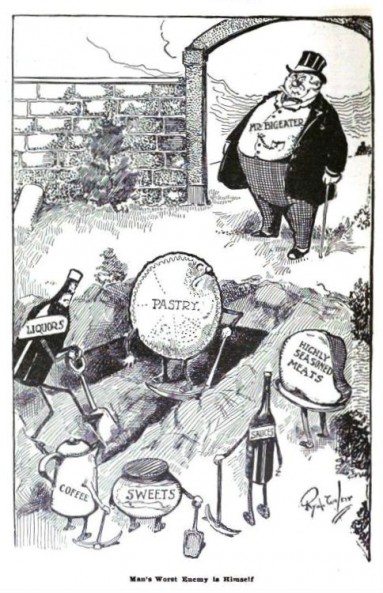Illustrations from Physical Culture, Vols. 8-9 (1902-1903)
Mrs. Trustle presided with genius and elan over New York's Physical Culture restaurant. A grandmotherly woman of about sixty, she had the energy of one half her age. With admirable dexterity, she stewed prunes, stirred simmering pots of beans, chopped cabbage, steamed carrots. Her girlish cheer was said to be infectious. The lunch rush never fazed her, and the dinner crowd she handled in stride.
The energetic cook was a disciple of Bernarr Macfadden
Born Bernard, Macfadden altered the spelling of his first name to "Bernarr," because he thought it sounded like a lion's roar.
, the pulp publishing magnate and founder of the American Physical Culture movement. He promulgated his philosophy of health in
Physical Culture magazine, which recommended that readers fast, lift weights and couple strenuously in order to remain hale and hearty. All over the country, Macfadden established "physical culture" training schools so that his adherents might have a place to practice these austerities.

He also established a small chain of restaurants in New York, the first of which, located in the Bowery, employed Mrs. Trustle. Macfadden saw to it that both rich
"The rich ate and drank freely, accepting gout and apoplexy as things that ran mysteriously in respectable families." -- George Eliot, Silas Marner (1861)
and poor had access to healthy food, initially charging a mere one cent per dish. Customers served themselves and selected from a variety of items: plates of beans, cabbage, steamed vegetables, hunks of bread, dried-fruit puddings. Macfadden was convinced of the success of his venture from the get-go. An eatery serving good food at a great price couldn't fail, he reasoned.
The Physical Culture restaurants did in fact thrive. Macfadden expanded his enterprise to accommodate wealthier patrons. Sectioned off from the one-cent restaurant, which occupied a basement, a five-cent restaurant offered more lavish dishes. Like their counterparts downstairs, customers upstairs served themselves food at once salutary and tasty. Indeed, the five-cent addition proved far more popular than the one-cent original; four pennies seemed a small premium for better selection and ambiance.

"Chuse leaner viands ye whose jovial make / Too fast the gummy nutriment imbibes; / Chuse sober meals, and rouse to active life / Your cumbrous clay, no on th' enfeebling down / Irresolute protract the morning hours..." from John Armstrong's Poems: Containing the Art of Preserving Health (1805)
"Why not throb with superior vitality! Why not possess the physical energy of a young lion? For then you will compel success. You will stand like a wall if need be, or rush with the force of a charging bison towards the desired achievements." -- Bernarr Macfadden, Vitality Supreme (1915)
"Steamed figs, served hot with cream, are a favorite dish at vegetarian and physical-culture restaurants. For a richer dish or preserve they may be simmered -- the dried ones -- in a rich syrup flavored with orange or lemon peel and some of the juice. When done, add a generous libation of wine, -- preferably Port. It keeps well and is convenient in winter, if one has not a supply of summer-made preserves to rely upon. Conveniently stored in the sideboard, it may come forth, when unexpected friends happen in for luncheon or a Sunday night supper, and will be sure to win praise. This is called by some Figs à la Genevieve." -- The Boston Cooking School Magazine of Culinary Science and Domestic Economics, Vol. 9 (1905)
Whether dining upstairs or downstairs, customers found these eateries a tremendous value. Many came every day, and some against their loved ones' wishes. One elderly gentleman brought his wife, who turned up her nose at the whole wheat bread, pea soup and steamed beans. Never would she adopt a diet so unrefined, she declared. Such food never appeared at her own table, so she saw no reason to eat it at another's. From then on her husband observed his regimen alone.
Other couples cottoned to Physical Culture cuisine. One pair, transplants from New England, ate twice daily in the restaurant. The woman worked in a factory -- and looked as if she did. But a few weeks of the hearty physical culture diet put flesh back on her bones and color back in her cheeks. With her husband she lunched on nuts and fruit and supped on more substantial dishes.
The restaurant proved so popular that Macfadden opened two more. They became meeting grounds for the city's physioculturists, many of whom saw a diet of simple foods as the path to a better life. "The most important thing is good health," he counseled, "for without good health nothing else is possible." The popularity of his restaurants revealed that, for better or for worse, many found these words fit provender.


